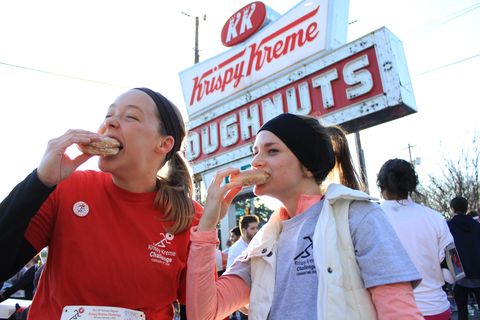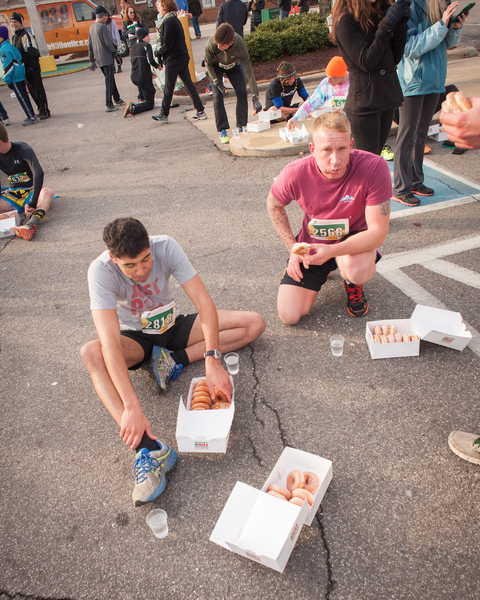Grabbing an energy gel midrace is one thing, but eating a dozen doughnuts? That’s an epic fail—or epic feat—waiting to happen. And on Saturday, February 1, thousands of runners are lining up in Raleigh, North Carolina, to take that risk at the Krispy Kreme Challenge.
For runners familiar with the beer mile, this race is just as challenging when it comes to food consumption and racing. To participate, runners must run five miles and eat a dozen glazed Krispy Kreme doughnuts midway through the race, all in under 60 minutes. The rules are strict: If you don’t eat all of the doughnuts or you take longer than an hour to complete the race, you’re technically not a finisher.
“Running the five miles is the easy part,” race director Georgia Burgess told Runner’s World. “The hard part is eating all of the doughnuts. Almost everyone who fails the challenge does so because they couldn’t eat them all.”
Burgess, who is a junior at N.C. State University, has been helping organize the Krispy Kreme Challenge since her freshman year. Since its inception 16 years ago, the student-run event has become a bucket-list race for competitive runners and eaters alike.
The first competition began as a dare between a few N.C. State undergrads in December 2004. The friends agreed to run from the Memorial Bell Tower on campus to the Krispy Kreme 2.5 miles away, down a dozen glazed doughnuts, then run back. That year, junior Ben Gaddy, a member of the university’s club rowing team, finished the seemingly impossible task in a time of 34:27.
News of Gaddy’s feat was quickly picked up by local media and spread around campus, and the race soon grew into a massive annual charity event in Raleigh. As of January 29, nearly 5,000 runners have registered for the 2020 race.
Not everyone signed up will attempt the challenge, though. Runners who don’t have the guts (literally) can opt to race as “casual” runners, which means they can carry the box of doughnuts with them to eat after the race. People can also participate as “no-doughnut” runners, meaning they don’t get a box of doughnuts.
Each year, a large portion of race proceeds go toward the UNC Children’s Hospital. So far, the Krispy Kreme Challenge has raised more than $1.7 million for the hospital, Burgess said. The rest of the entry fees ($25 for students and $30 for adults) go toward course setup and purchasing doughnuts.
Before the race kicks off at 8 a.m. on Saturday, Burgess and her team will pick up around 6,000 boxes of a dozen Krispy Kreme doughnuts, which will be stacked on tables at the turnaround point, ready to be devoured.
While finishing the challenge alone is impressive, some race to compete. The best race strategy is to run “as fast as humanely possible” for the first 2.5 miles, eat quickly, then try to hold yourself together on the way back, Burgess said.
Last year, Jacob Wormald, 23, from Pelham, New Hampshire, set the course record in a time of 29:18, averaging 5:51 per mile. According to his Instagram, it only took him four minutes and 11 seconds to eat all 12 doughnuts.
“There are a few ways to eat the doughnuts successfully,” Burgess said. “The worst way is to eat them one by one. If you do that, it’s either going to take too much time or you’re going to get too full to eat them all.”
One popular method of doughnut-eating is flattening three or four doughnuts on top of each other to form one pastry. “You can trick your mind into thinking that you’re only having three doughnuts when you’re really having more,” Burgess said.
Another way is to squeeze each doughnut into a ball, dip them in water, then eat them. “The water takes some of the sugar off and moistens the doughnut, so it goes down easier,” she said.
Burgess has also seen one particularly creative, if disturbing, method: smashing the whole dozen into a monster-sized doughnut ball.“Then you eat it like an apple,” she said. “It’s nasty.”
Amazingly, though they’re eating 2,400 calories at once, participants don’t throw up as often as you might think. “I’m always surprised at how well people can keep the doughnuts down,” she said. Still, she and the other volunteers set up plenty of trash cans along the course for runners who can’t hold their pastries in.
Oftentimes, participants stop eating—or running—before they get too nauseous. While 1,627 people attempted the doughnut challenge last year, only 1,360 actually completed it. Of the finishers, 169 were women and 1,191 were men. The first female finisher of 2019 was Leyla Kosakowski, 30, of Fairfax, Virginia, who finished in 45:05.
“I was a wimp my freshman year and ran as a ‘no-doughnut’ runner,” Burgess said. “I’d like to think that one day I’ll be able to finish it.”
From: Runner’s World US
Source: Read Full Article

